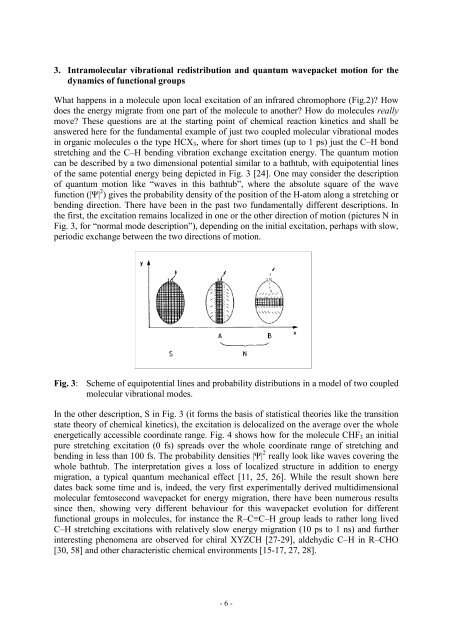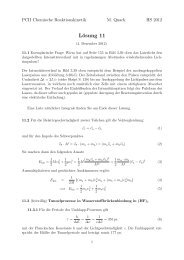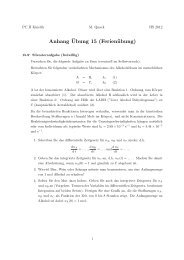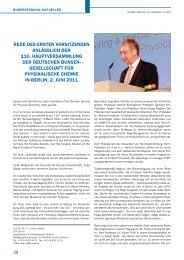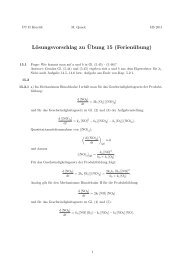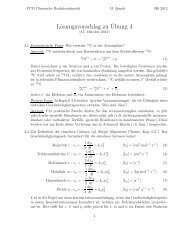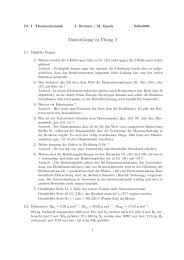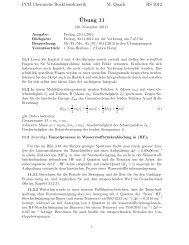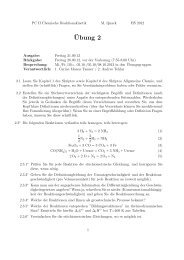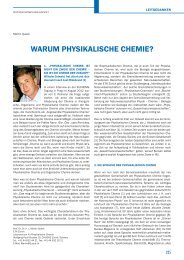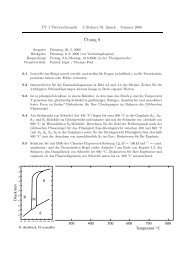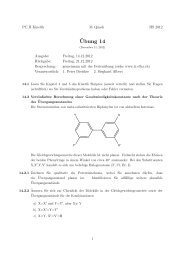Molecules in Motion - Quack - ETH Zürich
Molecules in Motion - Quack - ETH Zürich
Molecules in Motion - Quack - ETH Zürich
You also want an ePaper? Increase the reach of your titles
YUMPU automatically turns print PDFs into web optimized ePapers that Google loves.
3. Intramolecular vibrational redistribution and quantum wavepacket motion for the<br />
dynamics of functional groups<br />
What happens <strong>in</strong> a molecule upon local excitation of an <strong>in</strong>frared chromophore (Fig.2)? How<br />
does the energy migrate from one part of the molecule to another? How do molecules really<br />
move? These questions are at the start<strong>in</strong>g po<strong>in</strong>t of chemical reaction k<strong>in</strong>etics and shall be<br />
answered here for the fundamental example of just two coupled molecular vibrational modes<br />
<strong>in</strong> organic molecules o the type HCX 3 , where for short times (up to 1 ps) just the C–H bond<br />
stretch<strong>in</strong>g and the C–H bend<strong>in</strong>g vibration exchange excitation energy. The quantum motion<br />
can be described by a two dimensional potential similar to a bathtub, with equipotential l<strong>in</strong>es<br />
of the same potential energy be<strong>in</strong>g depicted <strong>in</strong> Fig. 3 [24]. One may consider the description<br />
of quantum motion like “waves <strong>in</strong> this bathtub”, where the absolute square of the wave<br />
function (|Ψ| 2 ) gives the probability density of the position of the H-atom along a stretch<strong>in</strong>g or<br />
bend<strong>in</strong>g direction. There have been <strong>in</strong> the past two fundamentally different descriptions. In<br />
the first, the excitation rema<strong>in</strong>s localized <strong>in</strong> one or the other direction of motion (pictures N <strong>in</strong><br />
Fig. 3, for “normal mode description”), depend<strong>in</strong>g on the <strong>in</strong>itial excitation, perhaps with slow,<br />
periodic exchange between the two directions of motion.<br />
Fig. 3: Scheme of equipotential l<strong>in</strong>es and probability distributions <strong>in</strong> a model of two coupled<br />
molecular vibrational modes.<br />
In the other description, S <strong>in</strong> Fig. 3 (it forms the basis of statistical theories like the transition<br />
state theory of chemical k<strong>in</strong>etics), the excitation is delocalized on the average over the whole<br />
energetically accessible coord<strong>in</strong>ate range. Fig. 4 shows how for the molecule CHF 3 an <strong>in</strong>itial<br />
pure stretch<strong>in</strong>g excitation (0 fs) spreads over the whole coord<strong>in</strong>ate range of stretch<strong>in</strong>g and<br />
bend<strong>in</strong>g <strong>in</strong> less than 100 fs. The probability densities |Ψ| 2 really look like waves cover<strong>in</strong>g the<br />
whole bathtub. The <strong>in</strong>terpretation gives a loss of localized structure <strong>in</strong> addition to energy<br />
migration, a typical quantum mechanical effect [11, 25, 26]. While the result shown here<br />
dates back some time and is, <strong>in</strong>deed, the very first experimentally derived multidimensional<br />
molecular femtosecond wavepacket for energy migration, there have been numerous results<br />
s<strong>in</strong>ce then, show<strong>in</strong>g very different behaviour for this wavepacket evolution for different<br />
functional groups <strong>in</strong> molecules, for <strong>in</strong>stance the R–C≡C–H group leads to rather long lived<br />
C–H stretch<strong>in</strong>g excitations with relatively slow energy migration (10 ps to 1 ns) and further<br />
<strong>in</strong>terest<strong>in</strong>g phenomena are observed for chiral XYZCH [27-29], aldehydic C–H <strong>in</strong> R–CHO<br />
[30, 58] and other characteristic chemical environments [15-17, 27, 28].<br />
- 6 -


